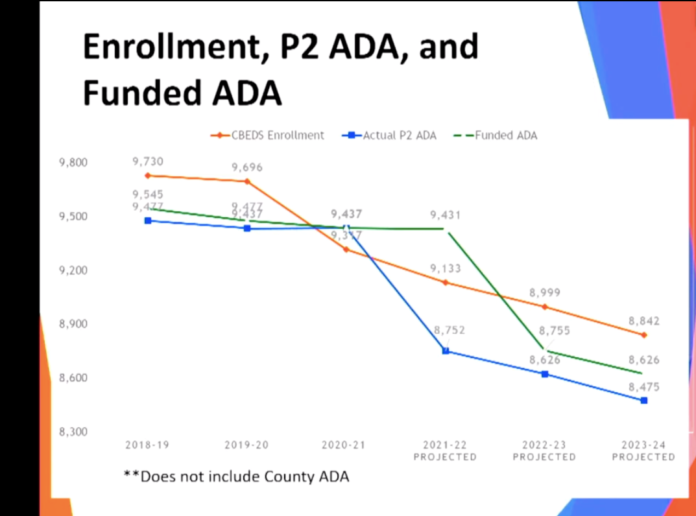The Los Alamitos Unified School District is facing some fiscal challenges starting in the 2022-2023 school year but district administrators are hopeful California’s governor and legislature will step in to help with extra funding.
That was the message during the March 8 Board of Education meeting when Elvia Galicia, Assistant Superintendent for Business Services, delivered a budget update.
A big jump in pension and employee health care costs is one issue. The other issue is California ending its policy that based school funding on pre-pandemic attendance and enrollment levels. This translates to increased spending and a potential decrease in funding.
“So, we have two big items that are really going to hit districts next year if [state lawmakers] don’t provide some relief,” Los Alamitos Unified Superintendent Dr. Andrew Pulver said during the meeting. “I have every belief that they will be providing some levels of relief.”
Los Alamitos USD is not alone. Many California school districts are facing similar budget challenges, as reported by EdSource last year.
Costs for Employee Benefits Increasing
Los Alamitos USD is paying more when it comes to retirement and healthcare benefits for employees. Galicia reported steep hikes for the district for both the CalSTRS, California’s retirement program for public school teachers, and CalPERS, the state’s retirement program for public employees. For CalSTRS, the cost increase will be an additional $1 million starting in the 2022-23 school year. For CalPERS, the annual cost increase will be around $400,000, according to Galicia.
In addition, the cost for employee health care benefits is going up. This year the cost per employee is $15,754. It’s projected to jump to $17,329 next year and then to $19,062 in the 2023-24 school year, according to Galicia.
She also said pay raises approved for district employees last year represent the bulk of increases in expenditures. “Overall, the unrestricted general fund had a decrease of $2 million and … that’s primarily for the negotiated salary increases,” Galicia told board members.
Transition to Funding Based on Current Attendance Rate amid declining Enrollment
While costs are increasing, funding is expected to decrease. Public schools are funded based on average daily attendance. Because the pandemic disrupted to TK-12 education, districts have been allowed to use pre-pandemic attendance levels for funding for the past two years. That changes next school year when current attendance levels will be used.
And not only is the district’s average daily attendance rate expected to be lower than predicted (95% compared to a projected 97%, according to Galicia), but so is enrollment.
A chart presented at the meeting showed three different representations for attendance enrollment and all showed declines. The most important one represents “Funded Average Daily Attendance,” meaning that’s the number tied to a dollar amount.
This year there are 9,431 students enrolled. Next year, it’s expected to drop to 8,755 and then in 2023-24 it’s expected to decrease to 8,626.
The dramatic drop has been referred to as the “cliff” by Dr. Pulver. “When you keep hearing everybody talk about the cliff, that … is the issue that they are trying to resolve.”
Options for Relief from the State
Both Governor Gavin Newsom and state lawmakers have discussed options for using extra revenue to help TK-12 schools but nothing official has been established or passed into law.
Advocates, including district administrators, are hoping for a boost to the base-level funding provided to districts and use of one-time funding to help pay for pension costs.
Another option is changing how funding for schools is calculated, moving away from basing it on average attendance to using average enrollment. That’s the aim of Senate Bill 830, which is co-sponsored by State Superintendent of Public Instruction, Tony Thurmond.
“This modification would help schools be funded more equitably and help schools struggling with absenteeism—and all schools—receive the financial support they need to recover from the pandemic and thrive in the future,” Thurmond said in a February press release.
For now, these are all just proposals. Galicia expects more information when Governor Newsom offers his revised budget in May.
Enjoy reading about local education news? For more coverage, subscribe to the Spotlight Schools weekly email newsletter at SpotlightSchools.com.

